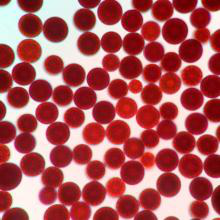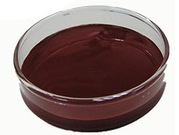High Performance Astaxanthin Factory in Burundi
High Performance Astaxanthin Factory in Burundi Detail:
[Latin Name] Haematococcus Pluvialis
[Plant Source] from China
[Specifications]1% 2% 3% 5%
[Appearance] Dark red Powder
[Particle size] 80 Mesh
[Loss on drying] ≤5.0%
[Heavy Metal] ≤10PPM
[Storage] Store in cool & dry area, keep away from the direct light and heat.
[Shelf life] 24 Months
[Package] Packed in paper-drums and two plastic-bags inside.
[Net weight] 25kgs/drum
Brief Introduction
Astaxanthin is a natural nutritional component, it can be found as a food supplement. The supplement is intended for human, animal, and aquaculture consumption.
Astaxanthin is a carotenoid. It belongs to a larger class of phytochemicals known as terpenes, which are built from five carbon precursors; isopentenyl diphosphate and dimethylallyl diphosphate . Astaxanthin is classified as a xanthophyll (originally derived from a word meaning “yellow leaves” since yellow plant leaf pigments were the first recognized of the xanthophyll family of carotenoids), but currently employed to describe carotenoid compounds that have oxygen-containing moities, hydroxyl or ketone , such as zeaxanthin and canthaxanthin. Indeed, astaxanthin is a metabolite of zeaxanthin and/or canthaxanthin, containing both hydroxyl and ketone functional groups. Like many carotenoids, astaxanthin is a colorful, lipid-soluble pigment. This colour is due to the extended chain of conjugated (alternating double and single) double bonds at the centre of the compound. This chain of conjugated double bonds is also responsible for the antioxidant function of astaxanthin (as well as other carotenoids) as it results in a region of decentralized electrons that can be donated to reduce a reactive oxidizing molecule.
Function:
1.Astaxanthin is a powerful antioxidant and may protect against oxidative damage to body tissues.
2.Astaxanthin can improve the immune response by increasing the number of antibody producing cells.
3.Astaxanthin is a potential candidate to treat neurodegenerative disease such as Alzhimer and Parkinson diease.
4.Astaxanthin dan reduce UVA-light damage to skin such as sunburn, inflammation, ageing and skin cancer.
Application
1.When applied in pharmaceutical field, astaxanthin powder has the good function of antineoplastic;
2.When applied in health food field, astaxanthin powder is used as food additives for pigment and health care;
3.When applied in cosmetic field, astaxanthin powder has the good function of antioxidant and anti-aging;
4.When applied in animal feeds field, astaxanthin powder is used as animal feed additive to impart coloration, including farm-raised salmon and egg yolks.
Product detail pictures:

Related Product Guide:
We thinks what buyers think, the urgency of urgency to act during the interests of a purchaser position of theory, allowing for much better high-quality, reduced processing costs, charges are more reasonable, won the new and outdated consumers the support and affirmation for High Performance Astaxanthin Factory in Burundi , The product will supply to all over the world, such as: Mecca, Florence, Iraq, Should any of these items be of interest to you, please let us know. We'll be satisfied to give you a quotation upon receipt of one's detailed specifications. We have our personal experienced R&D enginners to meet any of one's requriements, We appear forward to receiving your enquires soon'and hope to have the opportunity to work together with you in the future. Welcome to check out our company.
L-Arginine Arginine the active ingredient is packed with 5 heart-health enhancing super ingredients that promote healthy functioning of the heart by restoring the production of nitric oxide — necessary for preventing cardiovascular diseases. It is specially formulated to help regulate blood cholesterol levels, strengthen immunity and reduce recovery time, as well as provide faster healing of wounds and ailments. Referred to as the ‘Miracle Molecule’, L-Arginine has anti-aging properties too, besides the ability to regulate blood pressure, enhance sexual functioning and manage diabetes. What’s more, it is also helps relieve all kinds of chronic pains
Advisory:
These Products are nutritional supplement and not a medicine. This product is not intended to diagnose, treat, cure any disease. Please consult your health practitioners or medical advisor before using this product and do not stop the intake of any medicine you might be consuming.
Vestige L-Arginine should be avoided by people with asthma and herpes virus. Pregnant & nursing women and people with a history of cardiac attack should consult their health physician before consuming this product.
The Management Team at Vestige has the combined experience of pioneering MLM in the country. The professionals involved in establishing MLM companies and making them successful have turned entrepreneurs to bring forth the best of Opportunity and Products through Vestige.
Gautam Bali, Managing Director: Has held various key positions such as being the Advisor and the CEO at noted MLM companies and is successfully heading Vestige with his proficiency and expertise of the MLM and direct-selling industry.
Kanwar Bir Singh, Director IT: With years of experience in software development, programming, applications etc, at eminent Multi-national MLM companies, he efficiently heads the Vestige IT department.
Deepak Sood, Director Operations: Has spent a number of years heading the Logistics, Warehousing, Operations and Networking departments at renowned MLM organisations. With an eye for detail and efficiency, he oversees the Vestige Operations division.
With such professionals at the helm of affairs you can be rest assured that your business is in very safe hands and Vestige is going to be a Win-Win business for you.
Visit – https://www.myvestige.com..
For more Videos..
https://www.youtube.com/channel/UC30jXezs0iwnWpE06LV9pFw
For Joining Call 09826196360
https://www.ebay.com/sch/male-enhancement-specialists Kings Power Plus Sex Supplement 30 tbs
KINGS POWER PLUS
MALE ENHANCEMENT FORMULA
30 TABLETS
For Increased Sexual Function and Performance Dietary Supplement.
Ignite Sexual Performance
Increase Erection Size, Firmness and Girth
Produce Longer Lasting and More Intense Erections
Give Sustained Erections in 15 Minutes or Less
Create an Intense Sensation That Most Sexual Partners Will Never Feel
Natural And Safe
Alcohol Friendly
About The Male Enhancement Specialists: Male Enhancement Specialists: We help men all over the world achieve optimum sexual performance. Only the best for our clients because “You deserve to have a great sex life”!
It can be said that this is a best producer we encountered in China in this industry, we feel lucky to work with so excellent manufacturer.







